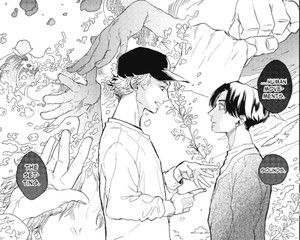The Spring 2025 Manga Guide
Love in the Palm of His Hand
What's It About?

Fujinaga is a university student who dreams of becoming an actor so he can do what he loves best—conveying emotion and story through physical expression. But after failing multiple auditions, his hopes are dashed and his confidence crushed. When he meets Keito, a fellow student with congenital hearing loss, Fujinaga is suddenly introduced to the world of sign language. Although clumsy at first, Fujinaga quickly picks up signing and surprises Keito with his astonishing talent of expressing emotions through action.
Is it that only in a place beyond all verbal limitations can two people, both yearning to be understood, forge a bond they never expected?
Love in the Palm of His Hand has story and art by Rinteku, with English translation by Jacqueline Fung and lettering by Kyla Aiko. Published by Square Enix Manga & Books (May 20, 2025). Rated OT.
Is It Worth Reading?
Rebecca Silverman
Rating:

There's always room for more diversity in romance fiction, and I'd even argue that romance is the genre that's made the most steps towards inclusivity, particularly in terms of western romance fiction. But manga romance has also made strides, and one place we can see that is in the increasing number of titles about Deaf protagonists to be translated into English. Love in the Palm of His Hand follows I Hear the Sunspot in the BL realm, and the short answer to the question you may be asking is, “Yes, if you liked that series, you'll like this one.”
They're hardly identical, though. Although both take place in college and feature a romance between a deaf and a hearing person, Love in the Palm of His Hand is more overtly romantic. Fujinaga first meets Keito on the train, when Keito falls asleep on his shoulder and can't be woken up. At first Fujinaga just assumes he's a deep sleeper and possibly doesn't speak Japanese (he mistakes the JSL word “thank you” for “namaste”), but later realizes that the younger man simply can't hear. Keito is friendly and instantly is delighted to make a new friend, but he's also impressed by Fujinaga's expressive body language, which interests Fujinaga in learning to sign.
The story is all about mutuality. Both Fujinaga and Keito want to understand each other and make efforts to communicate more easily, Fujinaga by learning JSL and Keito by speaking aloud when he can. Fujinaga is a stage actor attempting to make the leap to film, and Keito helps him to understand that his gift for expression, which reads as overdone to film directors, is actually a major plus for both his stage acting and communicating with people who can't hear. Fujinaga, meanwhile, shows Keita that he's more than just his disability; that he's a person others want to get to know and that he has a lot to offer in a relationship. They minimize each other's insecurities while enhancing their good traits, resulting in a remarkably healthy relationship even before it makes the shift to romance.
Unlike a few other series with Deaf protagonists (most notably A Sign of Affection), Keito's entire family speaks sign language. He's not isolated or sidelined, just living in a slightly different world, one he's willing to open up to others. Rinteku is adept at drawing different JSL words and phrases in detail, and the art is expressive. They note that there was necessary pick and choosing of which words to draw, but that makes sense – there's only so much room on the page, after all. And with a warm-hearted, sweet story like this one, it more than gets the point across. I'm looking forward to seeing this relationship continue to develop.
discuss this in the forum (28 posts) |
back to The Spring 2025 Manga Guide
Seasonal homepage / archives